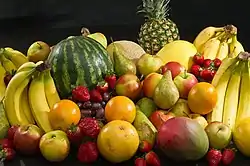日语
词源 1

(kudamono、kabutsu):各种各样的水果。
| 詞中漢字 | |
|---|---|
| 四年級 | もの 三年級 |
| 不規則 | 訓讀 |
字面意思为“树的东西”。原为由 (ku, 变迁自古旧ko发音) + (da, 罕用属格标记助词,仅见于少量复合词内) + (mono, “东西”)构成的复合词。[1][2]
中间的da亦见于 (kedamono, “野兽”, 字面意思是“有毛的东西”)。汉字为熟字訓。
发音
名词
• ()
近义词
衍生词汇
参见
词源 2
| 詞中漢字 | |
|---|---|
| か 四年級 |
ぶつ 三年級 |
| 漢音 | |
/kwabut͡su/ → /kabut͡su/
可能源自中古漢語组词 (*guɑ *miət)。对比现代官話 拼音guǒwù (罕用)、粵語 gwo2 mat6 (罕用)。
现代日語中罕用。
发音
- 國際音標(幫助):[ka̠bɯ̟ᵝt͡sɨᵝ]
名词
• () ← (kwabutu)?
- (罕用) 水果
用法说明
现代日语中读法最常用kudamono。
参考资料
- The Oxford Starter Japanese Dictionary. ISBN 0-19-860197-2
This article is issued from Wiktionary. The text is licensed under Creative Commons - Attribution - Sharealike. Additional terms may apply for the media files.